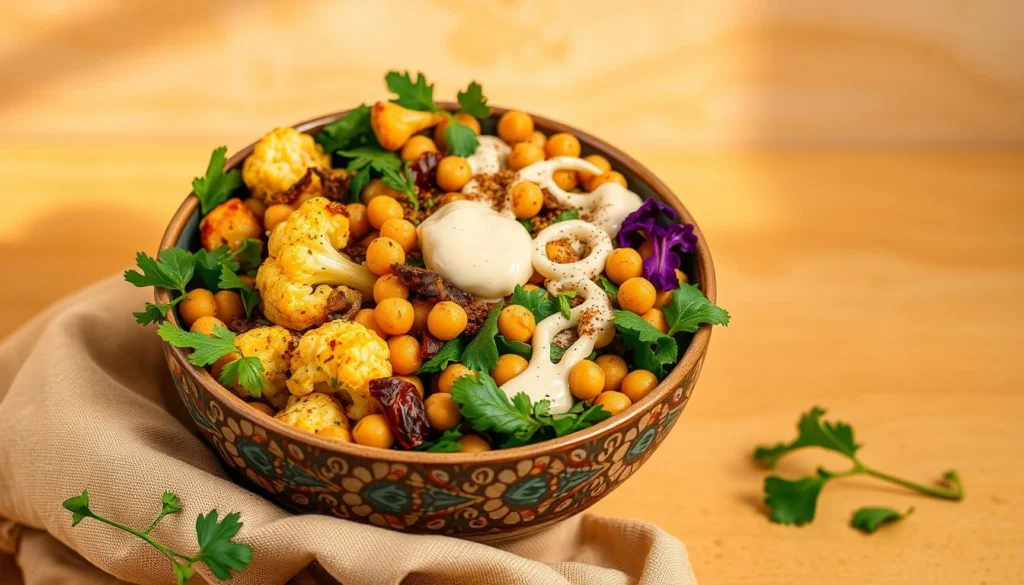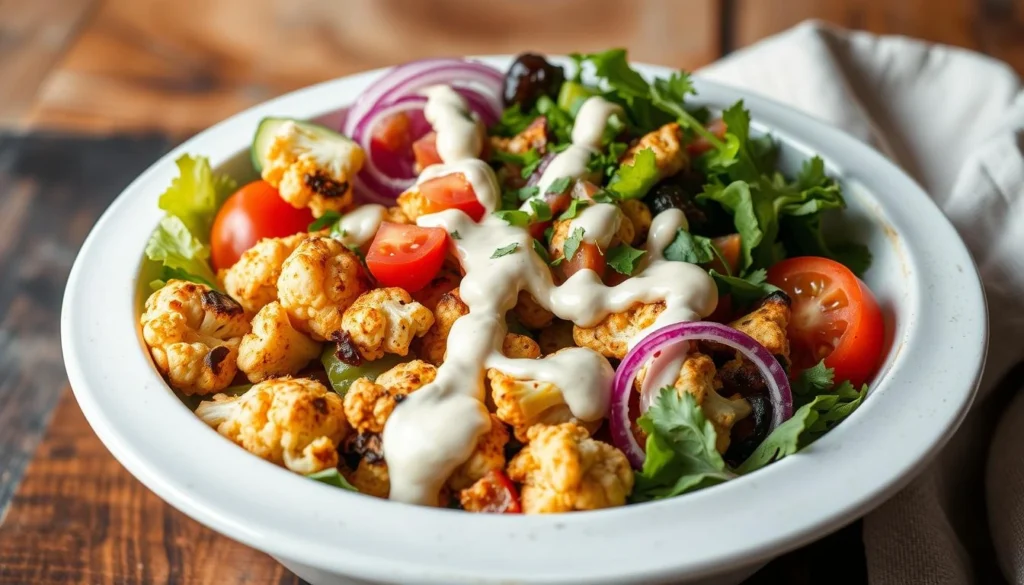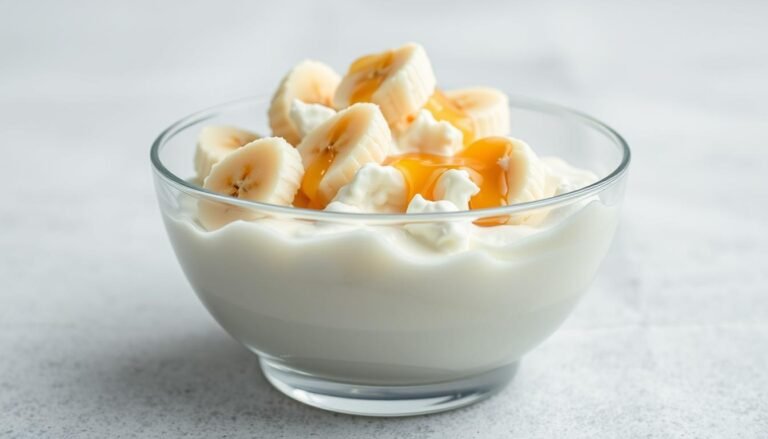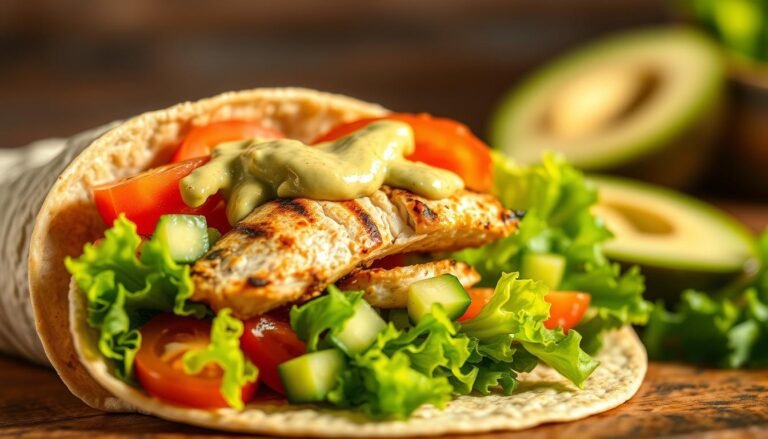Enjoy Cauliflower Shawarma Bowls: A Tasty Vegetarian Option
Table of Contents
The world of vegetarian cuisine is getting more exciting by the day, with plant-based meals taking center stage. One dish that’s gaining popularity is a creative twist on traditional Middle Eastern fare: a flavorful, filling bowl that’s perfect for a quick and healthy meal.

Cauliflower Shawarma Bowls offer a delicious and innovative vegetarian alternative to traditional shawarma. By combining the tender, slightly caramelized taste of roasted cauliflower with the bold flavors of Middle Eastern spices, this dish is sure to delight.
Key Takeaways
- Cauliflower Shawarma Bowls are a tasty and innovative vegetarian option.
- This dish combines the flavors of Middle Eastern cuisine with a plant-based twist.
- Perfect for a quick and healthy meal, it’s a great way to enjoy a vegetarian shawarma.
- The recipe is versatile and can be customized to suit various tastes.
- It’s an excellent choice for those looking to explore new vegetarian recipes.
The Delicious World of Middle Eastern Vegetarian Cuisine
The world of Middle Eastern vegetarian cuisine is a treasure trove of flavors and dishes. This culinary realm offers a diverse array of plant-based adaptations of traditional favorites, making it an exciting area to explore for vegetarians and food enthusiasts alike.
Plant-Based Adaptations of Traditional Dishes
Middle Eastern cuisine is known for its rich culinary heritage, with many traditional dishes being easily adapted to vegetarian versions. Classics like falafel, tabbouleh, and stuffed bell peppers showcase the region’s ability to create flavorful, meat-free meals. These dishes often rely on ingredients like chickpeas, lentils, and eggplant, which are staples in Middle Eastern cooking.
Key Ingredients in Vegetarian Middle Eastern Cuisine:
| Ingredient | Common Use | Flavor Profile |
|---|---|---|
| Chickpeas | Falafel, stews | Nutty, earthy |
| Lentils | Soups, salads | Mild, slightly sweet |
| Eggplant | Grilled, stews | Rich, meaty texture |
The Appeal of Bowl-Style Meals
Bowl-style meals have gained popularity worldwide, and Middle Eastern vegetarian cuisine is no exception. Shawarma bowls, in particular, offer a convenient and customizable way to enjoy the flavors of the region. By combining a protein source like cauliflower shawarma with various toppings and sauces, individuals can create a meal that suits their taste preferences.

The flexibility of bowl-style meals makes them an attractive option for those looking to explore new flavors and ingredients.
What Are Cauliflower Shawarma Bowls?
The concept of Cauliflower Shawarma Bowls brings a fresh twist to the classic shawarma, adapting it for vegetarian diets. This innovative dish retains the essence of traditional shawarma while substituting the meat with cauliflower, making it an appealing option for vegetarians and health-conscious individuals alike.
The Vegetarian Twist on a Middle Eastern Classic
Cauliflower Shawarma Bowls offer a creative vegetarian alternative to the traditional Middle Eastern street food. By using cauliflower as the main ingredient, this dish not only caters to vegetarians but also provides a lower-calorie version of the classic shawarma.
The vegetarian twist involves marinating cauliflower florets in a blend of spices typically used in shawarma, then roasting or grilling them to perfection.
Components of a Perfect Shawarma Bowl
A well-crafted Cauliflower Shawarma Bowl consists of several key components. Understanding these elements is crucial to creating an authentic and delicious vegetarian shawarma experience.
The Spiced Cauliflower Base
The foundation of a great Cauliflower Shawarma Bowl is the spiced cauliflower. This involves carefully selecting a mix of spices that complement the natural flavor of cauliflower, such as cumin, coriander, and sumac.
Essential Toppings and Garnishes
In addition to the spiced cauliflower, various toppings and garnishes enhance the flavor and texture of the bowl. Common additions include tahini sauce, pickled turnips, and fresh herbs like parsley or cilantro.
| Component | Description |
|---|---|
| Spiced Cauliflower | Marinated and roasted cauliflower florets |
| Tahini Sauce | Creamy sauce made from tahini, lemon juice, and garlic |
| Pickled Turnips | Thinly sliced turnips pickled in vinegar and spices |
| Fresh Herbs | Chopped parsley or cilantro for added freshness |

The History and Origin of Shawarma
Tracing the history of shawarma reveals a fascinating story of cultural exchange. Shawarma, a popular street food, has its roots in the Middle East, where it has been a staple for centuries. The dish has evolved over time, influenced by various cultures and cuisines.
Traditional Meat Shawarma Through the Ages
Traditionally, shawarma was made with thinly sliced meat, typically lamb or chicken, stacked on a vertical spit and served in a warm pita with vegetables and tahini sauce. This method of cooking was introduced to the Middle East by Turkish immigrants in the 19th century. The name ‘shawarma’ is derived from the Turkish word ‘çevirme,’ meaning ‘to rotate,’ which refers to the rotating spit used in cooking the meat.
The evolution of traditional shawarma was marked by its adaptation to local tastes and ingredients. In the Middle East, it became a beloved street food, with each region adding its unique twist to the recipe.
The Evolution of Vegetarian Adaptations
In recent years, vegetarian versions of shawarma have gained popularity, catering to the growing demand for plant-based options. Cauliflower shawarma has emerged as a particularly popular variant, offering a flavorful and nutritious alternative to traditional meat shawarma. This adaptation is a testament to the versatility of shawarma and its ability to be reimagined in various ways.
The development of vegetarian shawarma adaptations reflects a broader trend towards inclusive and sustainable food options. By incorporating a variety of vegetables and plant-based proteins, these versions not only cater to vegetarians and vegans but also offer a fresh perspective on a classic dish.
Health Benefits of Cauliflower Shawarma Bowls
Cauliflower Shawarma Bowls represent a perfect blend of taste and nutrition. These bowls are not just a treat for the taste buds but also offer numerous health benefits due to their nutrient-rich ingredients.
Nutritional Profile of Cauliflower
Cauliflower is a low-calorie, high-fiber vegetable rich in vitamins C and K, and it contains a wealth of antioxidants. Its nutritional profile makes it an excellent base for a healthy meal. The cruciferous nature of cauliflower also provides potential anti-inflammatory benefits.
Rich in vitamins and minerals, cauliflower supports overall health and well-being. It is also versatile and can be prepared in various ways to retain its nutritional value.
Plant-Based Protein Sources in These Bowls
Cauliflower Shawarma Bowls often include a variety of plant-based protein sources such as chickpeas, lentils, or tofu. These ingredients not only add protein but also complement the nutritional profile of cauliflower.
Complete Proteins Through Food Combinations
Combining different plant-based foods can provide all essential amino acids, making it easy to achieve complete proteins. For example, pairing grains with legumes or nuts with seeds can ensure a balanced intake of amino acids.
Fiber and Micronutrient Content
These bowls are also high in fiber and micronutrients, thanks to the variety of vegetables and whole grains used. A high fiber diet supports digestive health, while micronutrients like iron, zinc, and potassium are crucial for various bodily functions.
Essential Ingredients for the Perfect Cauliflower Shawarma Bowls
Creating the perfect Cauliflower Shawarma Bowls requires a thoughtful selection of essential ingredients. The beauty of this dish lies in its simplicity and the quality of its components. By focusing on a few key elements, you can create a flavorful and satisfying meal.
The Cauliflower Base
The star of the Cauliflower Shawarma Bowl is, of course, the cauliflower. You’ll need one large head of cauliflower, broken into florets. Freshness is crucial, so choose a firm, white cauliflower without any signs of browning or wilting. The cauliflower will be the base of your shawarma, so it’s essential to prepare it correctly.
Authentic Shawarma Spice Blend
A shawarma spice blend is what gives Cauliflower Shawarma its distinctive flavor. This blend typically includes a mix of spices such as cumin, coriander, paprika, turmeric, and cinnamon. The exact proportions can vary depending on personal preference and regional traditions.
Making Your Own Spice Mix
Creating your own shawarma spice blend from scratch allows you to customize the flavors to your liking. Start with equal parts cumin and coriander, then add smaller amounts of paprika, turmeric, and cinnamon. You can adjust these proportions to suit your taste.
Store-Bought Alternatives
If you’re short on time or prefer the convenience, you can use a store-bought shawarma spice blend. Many Middle Eastern or specialty grocery stores carry pre-mixed shawarma seasoning. Look for a blend that lists its ingredients and avoid mixes with fillers or excessive salt.
Complementary Bowl Components
Beyond the cauliflower and spice blend, several other ingredients are essential for a well-rounded Cauliflower Shawarma Bowl. These include a base such as rice, quinoa, or greens; toppings like diced tomatoes, cucumbers, and pickled turnips; and a sauce or dressing, such as tahini or garlic yogurt sauce. Choose components that complement the flavors and textures in your bowl.
Preparing Your Cauliflower for Shawarma
The key to a delicious Cauliflower Shawarma Bowl lies in the preparation of its star ingredient: the cauliflower. Proper preparation enhances the flavor and texture, making it a satisfying vegetarian option.
Cutting and Prepping Techniques
To prepare cauliflower for shawarma, start by removing the leaves and stem, then cut it into florets. You can either leave them as is or break them down further into smaller, more uniform pieces to mimic the traditional shawarma texture. Rinsing the cauliflower under cold water helps remove any impurities.
Marination Methods for Maximum Flavor
Marinating cauliflower is crucial for infusing it with the rich flavors of shawarma. There are two effective methods:
Quick Marinade Options
A quick marinade can be achieved in as little as 30 minutes using a mixture of olive oil, lemon juice, and shawarma spices.
Overnight Flavor Development
For deeper flavor penetration, marinate the cauliflower overnight. This allows the spices to fully incorporate into the vegetable, resulting in a more complex taste profile.
Cooking Methods for Perfect Cauliflower Shawarma
Mastering the art of cooking cauliflower shawarma involves understanding various culinary techniques that bring out the best flavors and textures. The cooking method you choose can significantly impact the final result, making it crucial to select the right approach for your cauliflower shawarma.
Roasting to Perfection
Roasting cauliflower is a popular method that enhances its natural sweetness and adds a deep, caramelized flavor. To roast cauliflower to perfection, preheat your oven to 425°F (220°C). Toss the cauliflower florets with olive oil, shawarma spice blend, and a pinch of salt. Spread them on a baking sheet in a single layer and roast for about 25-30 minutes, or until tender and golden brown.
This method is ideal for those who prefer a hands-off approach.
Air Fryer Technique
For a crisper exterior and a tender interior with less oil, the air fryer is an excellent choice. Simply marinate the cauliflower florets as desired, then cook them in the air fryer at 375°F (190°C) for about 15-20 minutes, shaking halfway through.
The air fryer technique yields a deliciously crispy cauliflower shawarma with minimal effort.
Stovetop Options
Cooking cauliflower shawarma on the stovetop allows for quick and precise control over the cooking process. Heat a skillet over medium-high heat, add a small amount of oil, and sauté the marinated cauliflower florets until they’re tender and slightly charred.
This method is perfect for those who prefer a quicker cooking time and the ability to stir and adjust seasoning on the fly.
By exploring these different cooking methods, you can find the perfect way to prepare cauliflower shawarma that suits your taste preferences and cooking style.
Building Your Cauliflower Shawarma Bowls
Assembling the perfect Cauliflower Shawarma Bowl is an art that combines flavors, textures, and presentation. It’s the final step in creating a meal that’s not only delicious but also visually appealing.
Base Options: Grains and Greens
The base of your Cauliflower Shawarma Bowl is crucial as it sets the foundation for the rest of the ingredients. You can choose between various grains and greens to suit your dietary preferences and taste.
- Grains: Options like quinoa, brown rice, or whole wheat couscous provide a nutritious and filling base.
- Greens: For a low-carb option, mixed greens or spinach make an excellent base, adding freshness and a burst of nutrients.
Sauce and Dressing Recipes
Sauces and dressings can elevate your Cauliflower Shawarma Bowl from good to great. Here are a couple of recipes to try:
Classic Tahini Sauce
Tahini sauce is a staple in Middle Eastern cuisine, known for its creamy texture and nutty flavor. To make it, blend tahini with lemon juice, garlic, and olive oil.
“Tahini sauce is the glue that holds the flavors of the shawarma together,” says a renowned chef in a culinary blog.
Yogurt-Based Alternatives
For a lighter option, yogurt-based sauces are a great alternative. Mix Greek yogurt with cucumber, garlic, and dill for a refreshing tzatziki sauce.
Assembly Tips for Instagram-Worthy Bowls
Assembling your bowl with a bit of thought can make it Instagram-worthy. Start with your base, then add the cauliflower shawarma, followed by other toppings and sauces. Finish with a sprinkle of sumac or paprika for a pop of color.
Delicious Variations of Cauliflower Shawarma Bowls
From Mediterranean-inspired flavors to innovative fusion dishes, Cauliflower Shawarma Bowls offer endless possibilities. This versatility is part of what makes them so appealing to a wide range of palates.
Mediterranean-Inspired Version
A Mediterranean-inspired Cauliflower Shawarma Bowl typically features ingredients like Kalamata olives, artichoke hearts, and feta cheese, all of which complement the cauliflower nicely. The addition of a tahini-based dressing enhances the overall flavor profile.
Fusion Flavors: Mexican-Middle Eastern Crossover
For a unique twist, consider blending Mexican and Middle Eastern cuisines. This can be achieved by adding spicy salsa or avocado crema to your bowl, alongside traditional shawarma spices. The result is a fascinating fusion that excites the taste buds.
Gluten-Free and Keto Adaptations
For those with dietary restrictions, Cauliflower Shawarma Bowls can easily be adapted. Using gluten-free tahini or ensuring that the spice blends are gluten-free can make the dish accessible to those with gluten intolerance. For a keto version, focus on high-fat ingredients like full-fat yogurt or avocado.
| Variation | Key Ingredients | Dietary Suitability |
|---|---|---|
| Mediterranean-Inspired | Olives, artichoke hearts, feta cheese | Gluten-free |
| Mexican-Middle Eastern Fusion | Spicy salsa, avocado crema, shawarma spices | Keto-friendly |
| Gluten-Free Adaptation | Gluten-free tahini, gluten-free spice blends | Gluten-free |
| Keto Adaptation | Full-fat yogurt, avocado, high-fat dressing | Keto-friendly |
Meal Prep and Storage Tips for Cauliflower Shawarma
Mastering meal prep is key to enjoying Cauliflower Shawarma Bowls throughout the week. With a few simple strategies, you can have a delicious, healthy meal ready in no time.
Make-Ahead Components
One of the best ways to simplify meal prep is to prepare components of your Cauliflower Shawarma Bowls in advance. This can include roasting the cauliflower, cooking the grains, and preparing the sauces and toppings. By having these elements ready, you can quickly assemble your bowls when you’re ready to eat.
Tip: Consider preparing a batch of cauliflower on the weekend and storing it in the fridge for up to 3 days.
Proper Storage and Reheating
To keep your Cauliflower Shawarma Bowls fresh, proper storage is essential. Store each component in separate, airtight containers to maintain freshness.
Keeping Elements Separate
Keeping the components separate is crucial for maintaining texture and flavor. Store the cauliflower, grains, and toppings in different containers.
Reviving Flavors When Reheating
When reheating, add a squeeze of fresh lemon juice or a sprinkle of sumac to revive the flavors. This simple step can make your reheated meal taste freshly made.
Serving Suggestions and Perfect Pairings
Transform your meal into a feast with our serving suggestions and perfect pairings for Cauliflower Shawarma Bowls. The right accompaniments can elevate the flavors and overall dining experience.
Beverage Recommendations
Choosing the right drink to accompany your Cauliflower Shawarma Bowl can enhance its flavors. Consider a refreshing mint lemonade or a ginger beer for a zesty contrast. For those who prefer wine, a dry Rosé or a Pinot Grigio pairs nicely.
Complementary Side Dishes
Complement your Cauliflower Shawarma Bowl with side dishes that add texture and flavor. Tabbouleh salad or grilled pita bread are excellent choices. For a heartier meal, consider adding roasted vegetables or a side of hummus.
| Side Dish | Description | Flavor Profile |
|---|---|---|
| Tabbouleh Salad | A fresh mix of parsley, tomatoes, and bulgur | Bright, herby |
| Grilled Pita Bread | Warm, crispy pita bread | Smoky, slightly charred |
| Roasted Vegetables | Seasonal vegetables roasted to perfection | Earthy, caramelized |
Turning Your Bowl into a Feast
To turn your Cauliflower Shawarma Bowl into a feast, consider adding a variety of dishes. Start with a mezze platter featuring falafel, stuffed grape leaves, and tabbouleh. Add some grilled meats or additional vegetarian options to create a diverse spread.
Conclusion: Embracing Plant-Based Middle Eastern Flavors
Cauliflower Shawarma Bowls offer a delicious and healthy vegetarian option that embodies the flavors and spirit of Middle Eastern cuisine. By incorporating plant-based ingredients and traditional Middle Eastern flavors, these bowls provide a unique culinary experience.
The versatility of Cauliflower Shawarma Bowls allows for various adaptations, making them suitable for different tastes and dietary needs. Whether you’re looking for a Mediterranean-inspired version or a fusion of flavors, these bowls are sure to satisfy your cravings.
Exploring plant-based Middle Eastern flavors can be a rewarding culinary journey. With Cauliflower Shawarma Bowls, you can experience the rich flavors of the region while enjoying a healthy and satisfying meal. So, don’t hesitate to get creative and start your plant-based culinary adventure today.
FAQ
What is Cauliflower Shawarma?
Cauliflower Shawarma is a vegetarian twist on the traditional Middle Eastern dish, where cauliflower is used instead of meat, typically lamb or chicken, and is served in a bowl with various toppings.
What are the health benefits of Cauliflower Shawarma Bowls?
Cauliflower Shawarma Bowls are rich in nutrients, fiber, and vitamins, and are low in calories. Cauliflower is a good source of antioxidants and contains compounds that have been shown to have anti-inflammatory properties.
Can I make Cauliflower Shawarma Bowls ahead of time?
Yes, you can prepare components of the bowl ahead of time, such as cooking the cauliflower, making the tahini sauce, and preparing the toppings. This makes it easy to assemble the bowls when you’re ready to eat.
What are some common toppings for Cauliflower Shawarma Bowls?
Common toppings include pickled turnips, sumac, parsley, tomatoes, and tahini sauce. You can also customize with your favorite toppings, such as avocado, grilled vegetables, or quinoa.
How do I achieve the perfect shawarma spice blend?
To achieve the perfect shawarma spice blend, you can mix together spices like cumin, coriander, paprika, garlic powder, and sumac. You can also buy pre-mixed shawarma spice blends at Middle Eastern grocery stores or online.
Can I make Cauliflower Shawarma Bowls gluten-free?
Yes, Cauliflower Shawarma Bowls can be made gluten-free by using gluten-free grains like quinoa or brown rice, and being mindful of the ingredients in your toppings and sauces.
What are some variations of Cauliflower Shawarma Bowls?
You can create variations by changing up the toppings, using different spice blends, or adding different protein sources like chickpeas or tofu. You can also experiment with different types of cauliflower, such as roasted or grilled.
How do I keep my Cauliflower Shawarma Bowls fresh?
To keep your Cauliflower Shawarma Bowls fresh, store the components separately in airtight containers in the refrigerator. Reheat the cauliflower and assemble the bowls just before eating.




